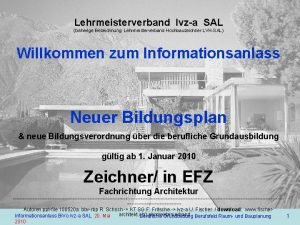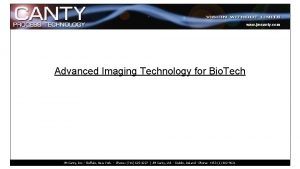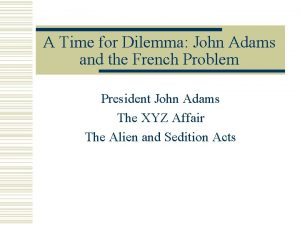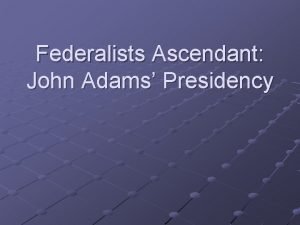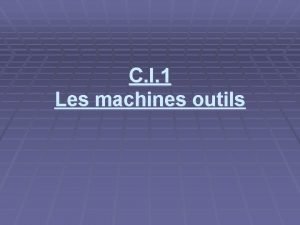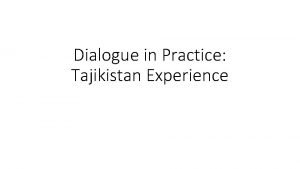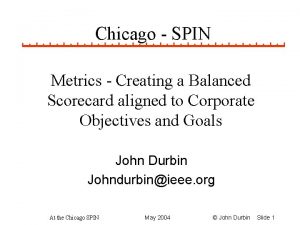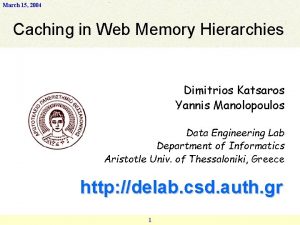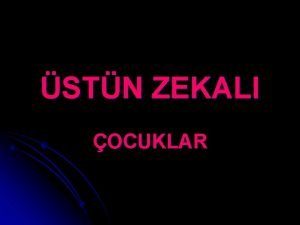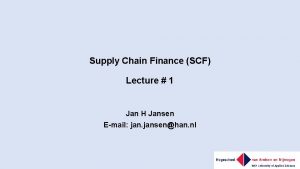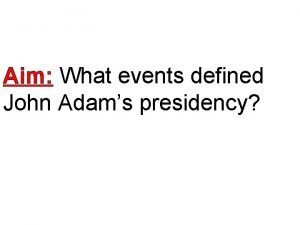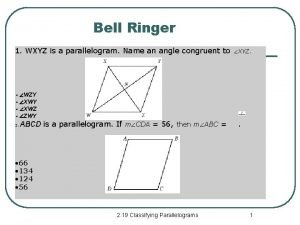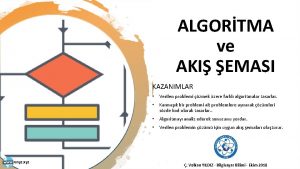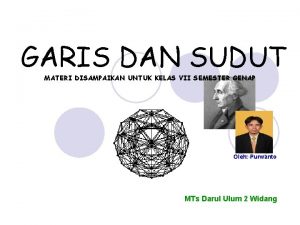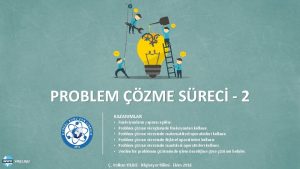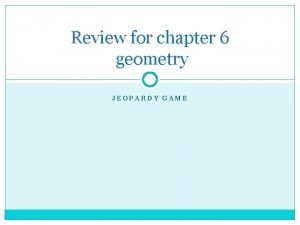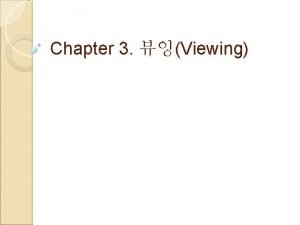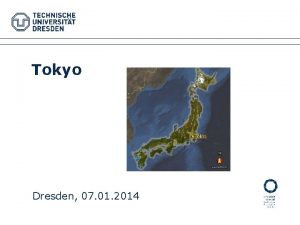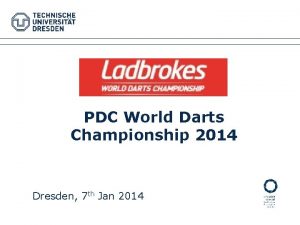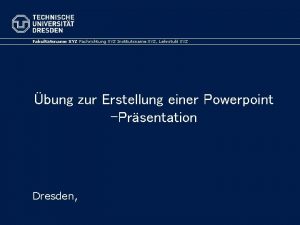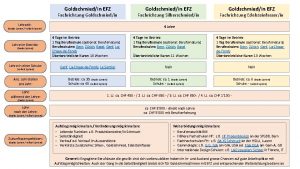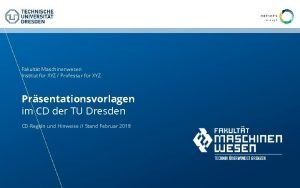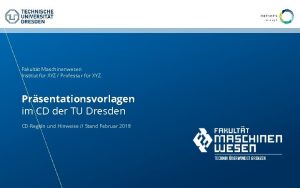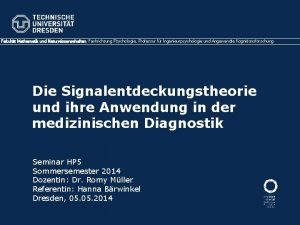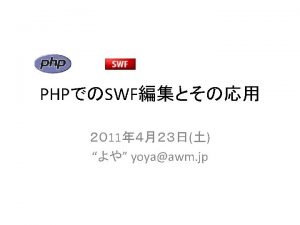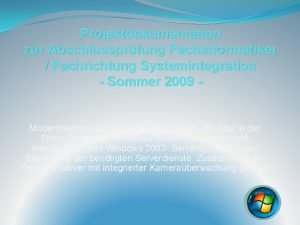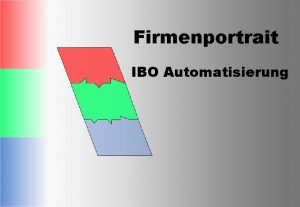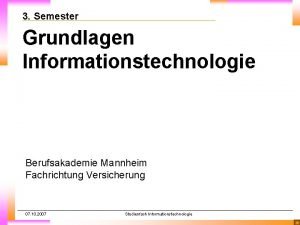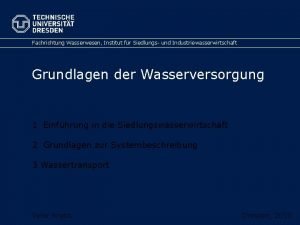Fakulttsname XYZ Fachrichtung XYZ Institutsname XYZ Professur XYZ

























- Slides: 25

Fakultätsname XYZ Fachrichtung XYZ Institutsname XYZ, Professur XYZ Common Workshop on Intercultural Communication for the master programmes „Ecosystem Services“ and „Biodiversity and Collection Management“ at IHI Zittau and Economy at TU Liberec IBZ St. Marienthal, Dec. 13 th + 14 th 2018 Oliver Tettenborn

Who are we?

Schedule of the workshop: Thursday, Dec. 13 th 2018 11. 45 Bus departure at TUL 12. 30 Bus departure at IHI 13. 00 Arrival at St. Marienthal, Lunch 14. 00 -15. 30 Introduction, key note speakers Coffee break 16. 00 – 18. 30 Group work, preparation of presentations 19. 00 Dinner 20. 00 Intercultural exercises and „socializing“

Schedule of the workshop: Friday, Dec. 14 th 2018 08. 00 Breakfast 09. 00 -12. 30 Excursion to Turów open-cast mine, Višnová and Lake Berzdorf 12. 30 Lunch at St. Marienthal 13. 30 – 14. 30 Final preparation of group presentations 14. 30 – 17. 30 (with a coffee break) Group presentations 17. 30 Resumee, Evaluation 18. 00 Bus departure for Zittau + Liberec

Topics for the group presentations: 1. Can ecological burdens turn into (economical and/or ecological) assets? Part I: Brownfields (Bočaková, Pospíchalová) 2. Can ecological burdens turn into (economical and/or ecological) assets? Part II: Open-cast mining, or: Can heavy impacts on ecosystems even enhance new biodiversity and leisure paradises? (Tettenborn) 3. Can ecological burdens turn into (economical and/or ecological) assets? Part III: Waste management, ground contamination etc. (Kalita, Jansa) 4. Plastics everywhere, part I: plastics in our households – is recycling a solution or a fake? What alternatives? (Jiránková, Šantinová)

Topics for the group presentations: 5. Plastics everywhere, part II: plastics in the oceans – causes, effects, solutions (Drahonovský, Plesarová) 6. Universalism vs. communitarian perspectives on ecological issues – i. e. Inuit and seal hunt, Japanese whale hunt etc. (Tettenborn) 7. Can a river be a person? Concepts of ecological values as non-objects/subjects (Tettenborn) 8. ? Fictitious companies? ? (Doubek, Žd‘arský)

Forming of diverse working teams: Calculate your cultural identity: 1 for 2 for 3 for + 1 for 4 for + 6 for Europeans Asians Americans or Africans men women Czechs No identical numbers in a team!

Links for the topics: https: //padlet. com/oliver_tett enborn/oyswn 9 p 63 sdz http: //www. youtube. com/watch? v=Fx. Nfhft. IR 2 o https: //www. economist. com/asia/2017/03/25/new-zealanddeclares-a-river-a-person http: //theconversation. com/when-a-river-is-a-person-fromecuador-to-new-zealand-nature-gets-its-day-in-court-79278 https: //en. wikipedia. org/wiki/Dakota_Access_Pipeline_protest s

Edgar Schein *1928 in Zürich (in a German-Hungarian Family. . . ), since 1938 in the USA; Organisation psychologist „Organizational culture“ Artifacts Values Assumptions since 1969

Edgar Schein „Organizational culture“ any tangible, overt or verbally identifiable elements in an organization such as architecture, furniture, dress code, office jokes. Artifacts are the visible elements in a culture and they can be recognized by people not part of the culture. Artifacts Values Assumptions

Edgar Schein „Organizational culture“ any tangible, overt or verbally identifiable elements in an organization such as architecture, furniture, dress code, office jokes. Artifacts are the visible elements in a culture and they can be recognized by people not part of the culture. Artifacts Values Assumptions - The organization's stated values and rules of behavior. - How the members represent the organization both to themselves and to others

Edgar Schein „Organizational culture“ any tangible, overt or verbally identifiable elements in an organization such as architecture, furniture, dress code, office jokes. Artifacts are the visible elements in a culture and they can be recognized by people not part of the culture. Artifacts - The organization's stated values and rules of behavior. - How the members represent the organization both to themselves and to others Values Basic Assumptions deeply embedded, taken-for-granted behaviours which are usually unconscious, but constitute the essence of culture. These assumptions are typically so well integrated in the office dynamic that they are hard to recognize from within.

Edgar Schein: „Organizational culture“ Definition of Culture: A pattern of common basic premisses, a group has learned by managing its problems of external adaption and internal integration, that has been proved worthwile and therefore is passed on to new members as the rationally and emotionally „correct“ way of solving these problems. The main problem in solving intercultural conflicts: We take OUR culture for granted in such a degree, that we feel uncomfortable talking about them or ask others about them. …and if we have to defend these cultural convictions, we tend to defend them not because of reasons but because of our emotional ties to them.

Communication Karl Bühler (1934) / Shannon and Weaver (1949) / Roman Jakobson (1960) Context (Reference) Precondition for identifying „content“/“issues“ to communicate about Sender/Source Message Receiver Precondition for a link between S + R Contact (Channel) Precondition for a common understanding of what is happening in communication TU Dresden, 25. 12. 2021 Code IHI Zittau – dílna evropského myšlení Folie 14 von 22

► Paul Watzlawick (1921 -2007) thinks, that communication consists of two components: ► Content, which is being transmitted (transactional function of language) ► Relationship aspects, in order to establish a succeeding social interaction (interactional function of language) TU Dresden, 25. 12. 2021 My resumee of Watzlawick: Intercultural Communication is a form of communication, in which the relationship aspect is especially significant for a succeeding communication. Our (western) tendency to underestimate this aspect leads IHI Zittau – dílna evropského myšlení Folie 15 von 22 us to communicative misinterpretations.

Communication as social interaction Following Jürgen Bolten „Kommunikation als soziale Interaktion“ (in: Bolten , „Interkulturelle Kommunikation“) Participant of Communication A Communikative Action Means of Communication (signs/symbols) Communikative Action is based on/ hints at Communication is a COMMON actualisation of meaning is based on/ hints at Stock of Meanings A (N. Luhmann nach G. H. Mead; zit. nach J. Bolten „Interkulturelle Kommunikation“) TU Dresden, 25. 12. 2021 Participant of Communication B Stock of Meanings B „I know, (s)he knows, that I „ know…“ (A. Schütz + T. Luckmann in: J. Bolten „Interkulturelle Kommunikation“) Understanding IHI Zittau – dílna evropského myšlení Folie 16 von 22

Friedemann Schultz von Thun‘s (*1944) four-side-model of communication TU Dresden, 25. 12. 2021 IHI Zittau – dílna evropského myšlení Folie 17 von 22

„Hey there, lights are green!“ Description of what we both see ahead of us. „I‘m in a hurry! The boss/my wife is waiting…“ „Go ahead! Step on the gas!“ „Why do you get in my way? “ TU Dresden, 25. 12. 2021 IHI Zittau – dílna evropského myšlení Folie 18 von 22

„Hey there, lights are green!“ Description of what he sees but I failed to notice. He surely thinks „Another woman who can‘t drive!“ „Go ahead! Step on the gas!“ „Such a naughty guy!“ TU Dresden, 25. 12. 2021 IHI Zittau – dílna evropského myšlení Folie 19 von 22

Lost in translation… „Most cross-cultural exploration begins with the annoyance of being lost. ” E. T. Hall „The potential for miscommunication is a function of differences in taken-for-granted. ” John J. Gumperz/Jenny Cook-Gumperz in: H. Kotthoff (Hg. ) “Handbook of intercultural communication”

John Austin (1911 -1960): “What do we do with words? ” „I’ll see you tomorrow!“ 1. Locutionary speech act: A sentence is formed, the participants of a communication can „de-code“ linguistically. („I understood his sentence: He told he would see me tomorrow“) 2. Illocutionary speech act: What the sender “really wanted to say” (respectively what the receiver thought that the sender “really wanted to say”). In our case: - A polite phrase without meaning (“maňana”) - …or a real promise? - …or a threat of a killer? 3. Perlocutionary speech act: The reaction, the sender intended to cause (respectively what the receiver thought the sender intended to cause). In our case: - The receiver looks forward for tomorrow and would be disappointed if the sender wouldn’t

Let‘s go back 2500 years… …to ancient rhetorics: Succeeding communication consists of: Ethos The receiver must believe in the credibility of the sender in order to be ready to receive the message. / The sender must convince the receiver in her/his credibility in order to transmit the message, to show (s)he‘s worth listening to. . Logos What is talked about („Message“) Pathos The receiver has to be „moved“: He musn‘t only understand intellectually, but has to be deeply „touched“ by the message. „If I don‘t trust you, I won‘t believe in any thing you said, may it be true or not. “ TU Dresden, 25. 12. 2021 Code IHI Zittau – dílna evropského myšlení Folie 22 von 22

Theses OT: ► IC competency mainly is the ability to learn to have a sound judgement on the relation between communicative manners and concrete human relationships. („Oh Lord, please don‘t let me be misunderstood!“) ► Essential for this is the ability to understand one‘s own and others‘ roles: If I simply insist on „authenticity“/ “honesty“, I ignore, that the other CANNOT „read me AS…“, unless our relationship is so strong, that there is only „you and me“. In all other cases, I have to be aware of our mutual roleplays (e. g. „The student/the teacher“) and the mutual expectations, linked to it. TU Dresden, 25. 12. 2021 IHI Zittau – dílna evropského myšlení Folie 23 von 22

„In order to have a fair selection, the task will be equal for everyone: Climb on that tree!“ TU Dresden, 25. 12. 2021 IHI Zittau – dílna evropského myšlení Folie 24 von 22

Thank you for your kind attention! TU Dresden, 25. 12. 2021 IHI Zittau – dílna evropského myšlení Folie 25 von 22
 Arbeitsbuch hochbauzeichner
Arbeitsbuch hochbauzeichner Hippo primary source analysis
Hippo primary source analysis Filego.xyz
Filego.xyz Jm canty sight glass
Jm canty sight glass The xyz affair dilemma
The xyz affair dilemma Whats the xyz affair
Whats the xyz affair Trièdre direct xyz
Trièdre direct xyz Xyz color space
Xyz color space Classificação xyz estoque
Classificação xyz estoque Groundbreakinguniform.xyz
Groundbreakinguniform.xyz Balanced scorecard terminology
Balanced scorecard terminology Cricket xyz
Cricket xyz Webmemory.xyz how to use
Webmemory.xyz how to use Zekal
Zekal Football route tree 0-9
Football route tree 0-9 Polyself.xyz paradigm
Polyself.xyz paradigm Marketing plan example
Marketing plan example Xyz affair summary
Xyz affair summary Parallelogram family tree
Parallelogram family tree Vnyz
Vnyz Sudut suplemen dari sudut 110 derajad adalah
Sudut suplemen dari sudut 110 derajad adalah Vnyz.xyz
Vnyz.xyz Equiangular quadrilateral rstu
Equiangular quadrilateral rstu X y z w
X y z w Xyz affair cartoon
Xyz affair cartoon Hacs xyz
Hacs xyz
